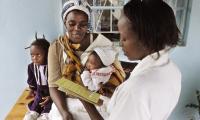Guiding the fight for sexual and reproductive health and rights

Sexual and reproductive health and rights (SRHR) is a vast, complex and sensitive area. The project partners have created a map of the area and and developed indicators to support the design, implementation, monitoring and evaluation of work in the area. The paper provides guidance for work with SRHR using the Availability, Accessibility, Acceptability and Quality-indicators (AAAQ).
The paper is an off spring of a collaborative capacity building project. The project partners are The Danish Family Planning Association (Sex & Samfund), Danish Red Cross, Global Nutrition and Health (Metropolitan University College) and Axis, together with the Danish Institute for Human Rights. Global Focus supported the project.
A life in freedom and dignity
Millions die every year of preventable maternal, neonatal conditions and sexually transmitted infections. Women and girls find themselves in miserable situations, caused by sexual abuse, unwanted pregnancies and unsafe abortions. SRHR constitute a global commitment to fight against these wrongs – not as a charity, but because every human being is entitled to a life in freedom and dignity.
The paper has two overall purposes; to map out Sexual and Reproductive Health (SRH) services as a sub-area of SRHR to support practical work in this complex and sensitive area, and to develop AAAQ indicators for each of the SRH service areas.
Using AAAQ-indicators
The analytical engine of the project is derived from the human rights criteria of Availability, Accessibility, Acceptability and Quality, which are derived directly from International Covenant on Economic, Social and Cultural Rights (ICESCR) and other instruments and authoritative interpretations.
In the context of sexual and reproductive health services, Availability refers to the existence and quantity of health facilities, goods and services. Accessibility refers to the physical and economic access to health facilities goods and services as well as accessibility on a non-discriminatory basis and with sufficient information. Acceptability refers to the sensitivity of health facilities, goods and services to culture and medical ethics. Quality refers to the need of health facilities, goods and services to be scientifically and medically appropriate and of good quality.
This is a great opportunity for us all to accelerate the work for SRHR on the ground, with a strong backing from the international human rights instruments and the 2030 agenda for sustainable development.
These human rights standards should be implemented in accordance with key human rights principles such as non-discrimination; participation and empowerment; and accountability and rule of law.
The paper does by no means provide a conclusive analysis of the complex issue area of SRHR. Rather, it is intended as inspiration to actors in the field of SRHR wishing to apply the AAAQ approach to protect and promote these human rights.
The AAAQ (Availability, Accessibility, Acceptability and Quality) approach is a generic methodology to assess essential aspects of social rights, applicable internationally, nationally and locally. Based on human rights standards and development policies and targets, the right in question can be given illustrative AAAQ indicators and benchmarks. That way the rights holders can determine whether their rights are being realized, and the duty bearers can see if they live up to their duties.
Sexual and Reproductive Health and Rights is an integral part of the right to health enshrined in article 12 of the International Covenant on Economic, Social and Cultural Rights, and a wide range of other international human rights instruments. Moreover, SRHR are firmly acknowledged in the 2030 agenda for the Sustainable Development Goals (SDGs). In particular, protection and promotion of SRHR stands out as a core pledge under SDG 3 on health, and SDG 5 on gender equality.
